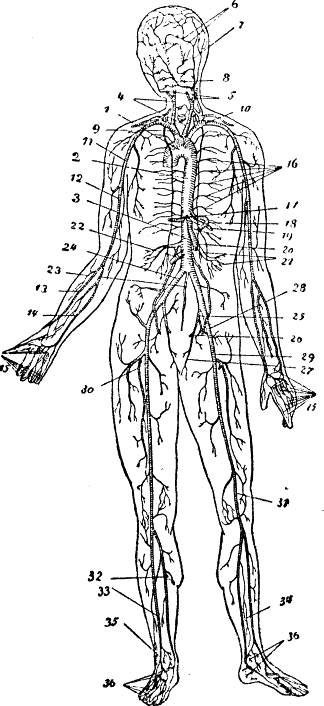Blood vessel

|
WikiDoc Resources for Blood vessel |
|
Articles |
|---|
|
Most recent articles on Blood vessel Most cited articles on Blood vessel |
|
Media |
|
Powerpoint slides on Blood vessel |
|
Evidence Based Medicine |
|
Clinical Trials |
|
Ongoing Trials on Blood vessel at Clinical Trials.gov Clinical Trials on Blood vessel at Google
|
|
Guidelines / Policies / Govt |
|
US National Guidelines Clearinghouse on Blood vessel
|
|
Books |
|
News |
|
Commentary |
|
Definitions |
|
Patient Resources / Community |
|
Patient resources on Blood vessel Discussion groups on Blood vessel Patient Handouts on Blood vessel Directions to Hospitals Treating Blood vessel Risk calculators and risk factors for Blood vessel
|
|
Healthcare Provider Resources |
|
Causes & Risk Factors for Blood vessel |
|
Continuing Medical Education (CME) |
|
International |
|
|
|
Business |
|
Experimental / Informatics |
Editor-In-Chief: C. Michael Gibson, M.S., M.D. [1]
Overview
The blood vessels are part of the cardiovascular system and function to transport blood throughout the body. The most important types, arteries and veins, carry blood away from or towards the heart, respectively.
Anatomy
All blood vessels have the same basic structure. The inner lining is the endothelium and is surrounded by subendothelial connective tissue. Around this there is a layer of vascular smooth muscle, which is highly developed in arteries. Finally, there is a further layer of connective tissue known as the adventitia, which contains nerves that supply the muscular layer, as well as nutrient capillaries in the larger blood vessels.
Capillaries consist of little more than a layer of endothelium and occasional connective tissue.
When blood vessels connect to form a region of diffuse vascular supply it is called an anastomosis (pl. anastomoses). Anastomoses provide critical alternative routes for blood to flow in case of blockages.
Laid end to end, the blood vessels in an average human body will stretch approximately 62,000 miles--2.5 times around the earth.
Types
There are various kinds of blood vessels:
- Arteries
- Aorta (the largest artery, carries blood out of the heart)
- Branches of the aorta, such as the carotid artery, the subclavian artery, the celiac trunk, the mesenteric arteries, the renal artery and the iliac artery.
- Arterioles
- Capillaries (the smallest blood vessels)
- Venules
- Veins
- Large collecting vessels, such as the subclavian vein, the jugular vein, the renal vein and the iliac vein.
- Venae cavae (the 2 largest veins, carry blood into the heart)
They are roughly grouped as arterial and venous, determined by whether the blood in it is flowing away from (arterial) or toward (venous) the heart. The term "arterial blood" is nevertheless used to indicate blood high in oxygen, although the pulmonary artery carries "venous blood" and blood flowing in the pulmonary vein is rich in oxygen.
Physiology
Blood vessels do not actively engage in the transport of blood (they have no appreciable peristalsis), but arteries - and veins to a degree - can regulate their inner diameter by contraction of the muscular layer.This changes the blood flow to downstream organs, and is determined by the autonomic nervous system. Vasodilation and vasoconstriction are also used antagonistically as methods of thermoregulation.
Oxygen (bound to hemoglobin in red blood cells) is the most critical nutrient carried by the blood. In all arteries apart from the pulmonary artery, hemoglobin is highly saturated (95-100%) with oxygen. In all veins apart from the pulmonary vein, the hemoglobin is desaturated at about 70%. (The values are reversed in the pulmonary circulation.)
The blood pressure in blood vessels is traditionally expressed in millimetres of mercury (1 mmHg = 133 Pa). In the arterial system, this is usually around 120 mmHg systolic (high pressure wave due to contraction of the heart) and 80 mmHg diastolic (low pressure wave). In contrast, pressures in the venous system are constant and rarely exceed 10 mmHg.
Vasoconstriction is the constriction of blood vessels (narrowing, becoming smaller in cross-sectional area) by contracting the vascular smooth muscle in the vessel walls. It is regulated by vasoconstrictors (agents that cause vasoconstriction). These include paracrine factors (e.g. prostaglandins), a number of hormones (e.g. vasopressin and angiotensin) and neurotransmitters (e.g. epinephrine) from the nervous system.
Vasodilation is a similar process mediated by antagonistically acting mediators. The most prominent vasodilator is nitric oxide (termed endothelium-derived relaxing factor for this reason).
Permeability of the endothelium is pivotal in the release of nutrients to the tissue. It is also increased in inflammation in response to histamine, prostaglandins and interleukins, which leads to most of the symptoms of inflammation (swelling, redness and warmth).
Role in disease
Blood vessels play a role in virtually every medical condition. Cancer, for example, cannot progress unless the tumor causes angiogenesis (formation of new blood vessels) to supply the malignant cells' metabolic demand. Atherosclerosis, the formation of lipid lumps (atheromas) in the blood vessel wall, is the prime cause of cardiovascular disease, the main cause of death in the Western world.
Blood vessel permeability is increased in inflammation. Damage, due to trauma or spontaneously, may lead to haemorrhage. In contrast, occlusion of the blood vessel (e.g. by a ruptured atherosclerotic plaque, by an embolised blood clot or a foreign body) leads to downstream ischemia (insufficient blood supply) and necrosis (tissue breakdown).
Vasculitis is inflammation of the vessel wall, due to autoimmune disease or infection.
External Links
See also
cs:Céva da:Blodåre de:Blutgefäß et:Veresoon hr:Krvne žile id:Pembuluh darah it:Vaso sanguigno ku:Xwînborî la:Vas sanguineum lv:Asinsvadi lt:Kraujagyslė mk:Крвни садови nl:Bloedvat no:Blodåre nn:Blodåre nds:Bloodfatt sq:Enët e gjakut simple:Blood vessel sk:Cieva (anatómia) sl:Žila sr:Крвни судови fi:Verisuoni sv:Blodkärl uk:Кровоносні судини yi:אדערן